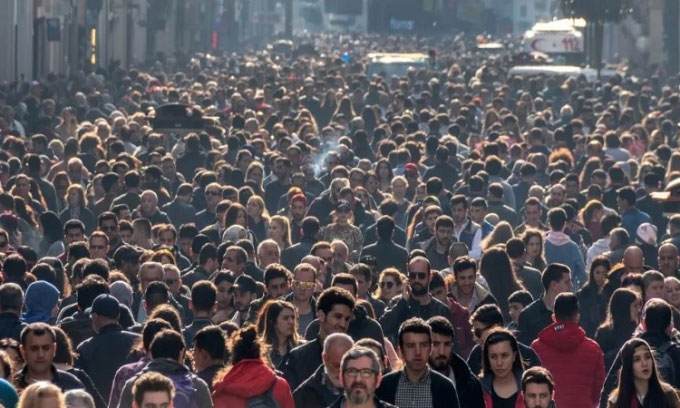Researchers predict that the world population will reach 10.4 billion by the 2080s, but the exact number of people that Earth can sustain remains unknown.
About 300,000 years ago, when Homo sapiens began to emerge, the total population was very small, estimated to be between 100 and 10,000 individuals. According to Joel E. Cohen, director of the Population Laboratory at Rockefeller University and Columbia University in New York, due to the initial low numbers, it took approximately 35,000 years for the human population to double.

The world population reached 8 billion on November 15, 2022. (Photo: Ayhan Altun)
After the advent of agriculture approximately 15,000 to 10,000 years ago, there were about 1 to 10 million people on Earth. It then took 1,500 years for the population to double. By the 16th century, the time required for the population to double had shortened to 300 years. In the 19th century, this figure dropped to just 130 years. From 1930 to 1974, the global population doubled in only 44 years. However, will the population continue to grow at this rate, and is there a limit to how many people the Earth can support?
In 1679, Antoni van Leeuwenhoek, a scientist and inventor of the microscope, predicted that the Earth could support 13.4 billion people. He calculated that the Netherlands occupied 1/13,400 of the Earth’s habitable land and multiplied the then-population of 1 million in the Netherlands by 13,400. Over 40 years of research, Cohen has gathered 65 estimates ranging from one billion to over one trillion people. He states that in a stable environment, the population will stabilize if the birth rate equals the death rate. However, environmental changes such as pollution or epidemics can increase or decrease the carrying capacity of the environment.
As Cohen explains, the carrying capacity in terms of population depends on both natural pressures and human choices. For example, natural pressures include food scarcity and harsh environments. Human choices encompass interactions between economies, agriculture, how people produce and consume goods, birth rates, average life expectancy, and migration.
“If we consider a rate where each couple has two children, the population will grow relatively steadily. If the birth rate is less than two, from one generation to the next, the population will decline. If the birth rate exceeds that and the vast majority of people survive, the population will increase,” said Patrick Gerland, a researcher at the United Nations Population Division in New York.
Many low-income countries around the world have high birth rates and large family sizes, coupled with high infant mortality rates and shorter life expectancies. However, as they reach a certain level of socio-economic development, more countries tend to have families with two children or fewer.
Global population growth peaked in the 1960s and has slowed since then. In 1950, the average birth rate was 5.05 children per woman, according to the United Nations Population Division. By 2020, this number had decreased to 2.44 children per woman. According to Gerland, researchers currently agree that the global population will peak again by the end of this century. It is expected that the world population will reach 10.4 billion by the 2080s and remain at that level until 2100.
The number of people that Earth can sustain is not a fixed figure. How humans produce and use natural resources affects the environment’s ability to sustain the population in the future. In other words, there may be limits to the number of people the Earth can support, but we do not know exactly what that number is.


















































